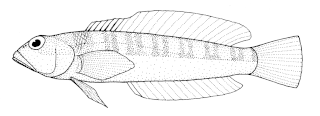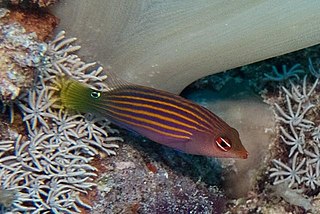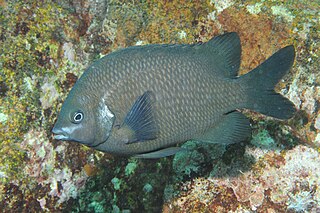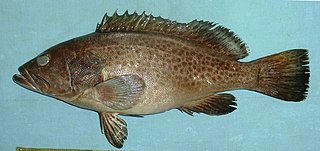
The red velvetfish is a species of marine ray-finned fish, it is the only species in the monotypic genus Gnathanacanthus and monogeneric family Gnathanacanthidae. This species is endemic to the inshore waters of western and southern Australia.

Cirrhitidae, the hawkfishes, are a family of marine perciform ray-finned fishes found in tropical seas and which are associated with coral reefs.

Eleotridae is a family of fish commonly known as sleeper gobies, with about 34 genera and 180 species. Most species are found in the tropical Indo-Pacific region, but there are also species in subtropical and temperate regions, warmer parts of the Americas and near the Atlantic coast in Africa. While many eleotrids pass through a planktonic stage in the sea and some spend their entire lives in the sea; as adults, the majority live in freshwater streams and brackish water. One of its genera, Caecieleotris, is troglobitic. They are especially important as predators in the freshwater stream ecosystems on oceanic islands such as New Zealand and Hawaii that otherwise lack the predatory fish families typical of nearby continents, such as catfish. Anatomically, they are similar to the gobies (Gobiidae), though unlike the majority of gobies, they do not have a pelvic sucker.

The silver sweep, also known as the false pompano, sweep, trumps or windawindawi, is a species of marine ray-finned fish from the subfamily Scorpidinae of the sea chub family Kyphosidae. It is native to the southwestern Pacific Ocean from Australia to New Zealand.

The red morwong, also known as the sea carp, is a species of marine ray finned fish traditionally regarded as belonging to the family Cheilodactylidae, the members of which are commonly known as morwongs. It is found off southeast Australia and the North Island of New Zealand from shallow depths to at least 55 m, on rocky reef and coastal areas. Its length is between 30 and 60 cm.

The redbanded weever is a sandperch of the family Pinguipedidae found around Australia and New Zealand at depths between 50 and 440 metres. Its length is up to 20 centimetres (7.9 in).

Ostorhinchus cyanosoma, commonly known as the yellow-striped cardinalfish, goldenstriped cardinalfish, or the orange-lined cardinalfish, is a species of marine fish in the cardinalfish family of order Perciformes. It is native to the Indo-West Pacific.

The six-line wrasse is a species of marine ray-finned fish from the family Labridae which has a wide Indo-Pacific distribution. This species is associated with coral reefs and can be found in the aquarium trade.

The southern blue devil is a species of fish in the longfin family Plesiopidae endemic to southern Australia. It is a close relative of the eastern blue devil, which lives in the coastal waters of eastern Australia, and of the western blue devil, of southwestern Western Australia with which it is sometimes considered conspecific.

Paraplesiops is a genus containing five largely allopatric species of fishes in the longfin, or roundhead, family Plesiopidae, commonly known as blue devils, bluedevils, or blue devilfish because of their colouration. The genus is most similar to the tropical genera Plesiops and Fraudella. It is restricted to subtropical and temperate rocky and coral reefs in Australian waters. Its species are mostly cryptic, occurring in submarine caves, crevices and under rocky ledges.

The western blue devil is a species of fish in the longfin family Plesiopidae endemic to Western Australia. The fish is found in rocky reef habitats in the coastal, inshore waters of southwestern Western Australia, from the Recherche Archipelago to Lancelin. The specific name was coined as a memorial to the ichthyologist Nicholas Sinclair of the Australian Museum who was involved in the collection of the type specimens.

Alison's blue devil is a species of fish in the longfin family Plesiopidae. It was described in 1984 and named for Alison Kuiter, the wife of Rudie Kuiter, because he said she saw the species first. It has a brown head and body with iridescent blue spots on the head. It has been recorded from various sites in southern Australian waters, including Port Phillip in Victoria, northern Tasmania and Tasmanian islands in Bass Strait, Kangaroo Island, and Victor Harbor in South Australia.

Valenciennea helsdingenii is a species of goby from the Indo-Pacific. It is commonly known as the twostripe goby, black-lined sleeper goby, or railway sleeper goby. It can grow up to a length of 25 cm (9.8 in) and is distinguishable by two prominent orange to black lines running longitudinally through its body.

Platycephalus caeruleopunctatus, the bluespotted flathead, drift flathead, Eastern blue-spot flathead, longnose flathead, red flathead, red spotted flathead, sand flathead or yank, is a species of predatory ray-finned fish belonging to the family Platycephalidae, the flatheads. Bluespotted flathead are a marine species and are predominantly found in offshore waters and coastal bays on the east coast of Australia where they are almost exclusively found on marine sand.

Notolabrus gymnogenis, commonly known as the crimson banded wrasse, is a species of fish in the family Labridae. This colourful fish is endemic to Eastern Australia.

The immaculate damselfish, also known as the green puller, is a species of ray-finned fish, it is the only species in the monotypic genus Mecaenichthys, classified in the subfamily Pomacentrinae of the family Pomacentridae.

Atypichthys strigatus, commonly known as the mado, is a species of fish in the family Kyphosidae. This fish is endemic to Eastern Australia.

Parma microlepis, commonly known as the white-ear, is a species of fish in the family Pomacentridae. This fish is endemic to Eastern Australia.

Epinephelus bleekeri, the duskytail grouper, Bleeker's grouper or Bleeker's rockcod, is a species of marine ray-finned fish, a grouper from the subfamily Epinephelinae which is part of the family Serranidae, which also includes the anthias and sea basses. It is found in the Indo-Pacific region where it is associated with shallow banks.

Lutjanus endecacanthus, the Guinea snapper, is a species of marine ray-finned fish, a snapper belonging to the family Lutjanidae. It is found on the west coast of Africa in the eastern Atlantic Ocean.




















